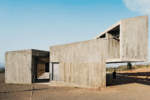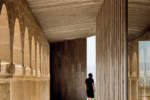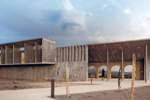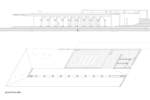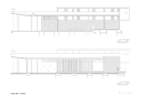architect: Juan Miguel Otxotorena
location: La Rioja, Spain
year: 2008
This project has had to tackle various questions and problems, on the one side linked to the way in which the hermitage is used and, on the other, to the location of the building and the need to integrate existing elements. We have deemed it necessary to create a relatively large sheltered area in front of the entrance, as protection against rain and sun, in view of the typical conditions of use of this kind of buildings, where individual worship is combined with popular ceremonies that draw large crowds. We also wanted to make it possible for visitors to see the image of the Virgen de la Antigua both from the inside and the outside, in moments when the building is closed. In fact, particular dedication has been dedicated to the dimension of the spaces, the hierarchic distinction between the external accesses and the internal ones communicating with the closed area of the chapel, and to the illumination – natural and artificial – which had to be as conductive as possible to the meditative atmosphere of a place of worship. The area of the hermitage was moreover supposed to represent, thanks to its location by a cliff on a hillside, by the road leaving the town, a new landmark visible from afar. We have therefore chosen to accentuate its horizontal lines, to offset the vertical ones of the cliff. To do all these elements justice, and to integrate in the plan an existing row of arches, which needed to be given more emphasis, the building has been ideated as a means of framing these arches, by arranging the pavement and the roof so as to create two parallel lines that form a frame around them. We have built it solely in untreated concrete, a simple and immediate material, capable of giving the building abstraction, continuity, stability and solidity.
Born in 1959 in San Sebastian, Juan Miguel Otxotorena Elizegi has lived in Pamplona since 1976, which was when he went to the city to start his university studies. He graduated as an architect at the Navarre University in 1983. He was distinguished with an Extraordinary Award for his Doctorate in1987. In 1990 he was appointed amongst many candidates the professorship of the Architectural Form Analysis Chair at Valladolid University, where he taught until 1994. For 15 years – from that time until up to September 2009 – he was the Director of the Pamplona School of Architecture at the University of Navarre. He is still practices as a Professor and Director of the Projects Department. His experience in the free exercise of the profession started in 1989. He has obtained successive recognition on constructed buildings, amongst which we can highlight the second European Prize for Architecture of Sports Facilities (1999), and a whole series of open project competitions first prizes — on his own or associated with other architects —, such as those referred to the sports centres in Estella and Olazagutía, the new Headquarters of the Parliament in Navarra, The Palace of Congresses and Auditorium of Pamplona and the reconditioning of the León Cathedral cloisters.



